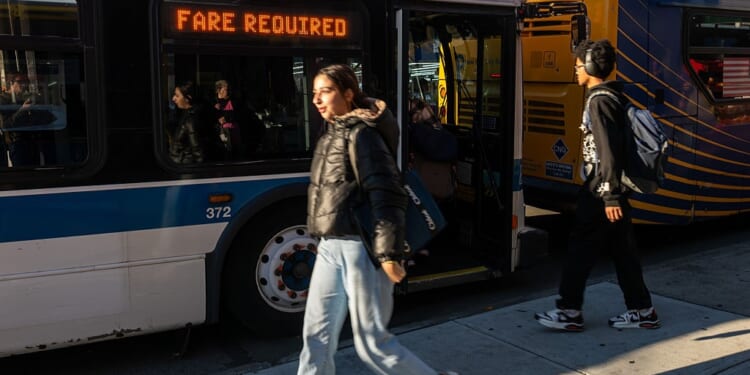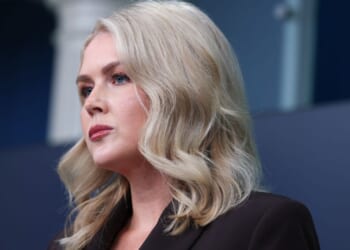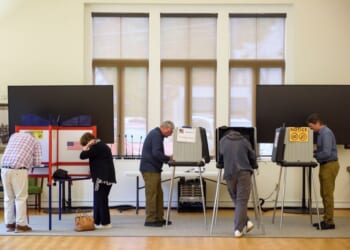New York Gov. Kathy Hochul is not a fan of Zohran Mamdani’s promise of free buses for everyone. Mamdani was recently elected New York City’s next mayor and will be sworn in on Jan. 1, 2026. While she claims to support making public transit more affordable, she could not back a plan that removes such a large revenue source from the Metropolitan Transportation Authority, known as the MTA.
“I cannot set forth a plan right now that takes money out of a system that relies on the fares of the buses and the subways,” Hochul said. “But can we find a path to make it more affordable for people who need help? Of course, we can.”
Is There Such a Thing as Free Buses?
Currently, the cost to ride a New York City bus is $2.90 for local and limited-stop routes, and $7 for express buses, according to the MTA. The agency’s fare revenues remain one of its major funding sources. A 2023 report from the Independent Budget Office (IBO) estimated that local bus fares alone brought in about $708 million in annual revenue for 2022, the most recent data found. That money helps pay for drivers, maintenance, and service expansions across the five boroughs.
The city already has programs to make transit more affordable. The Fair Fares NYC initiative gives low-income residents a 50% discount on subway and bus rides. According to city budget data, the program has been funded at about $75 million a year, and the IBO estimates roughly $32 million in discounted bus fares are already subsidized for low-income users.
Mamdani’s proposal would eliminate fares entirely, making all bus rides free for everyone regardless of income. His campaign estimated the plan would cost around $800 million a year. The IBO’s own projection placed the figure at roughly $652 million annually. Either way, the plan would require massive funding to replace what fares currently bring in. Without it, the MTA would face a substantial shortfall that could affect operations across the transit system.
Hochul’s refusal to support the measure highlights the political and financial tension between state and city governments. The MTA is a state-run agency, meaning any changes to fare policy would require Albany’s approval. Hochul, who has emphasized fiscal restraint, suggested that free buses simply aren’t financially viable right now.
Mamdani has argued that free public buses would create a fairer and more accessible city. “New York, tonight you have delivered a mandate for change,” he said in his victory speech after the mayoral election. “We campaigned on ideas like free buses and affordable housing, and I look forward to delivering on them.”
Supporters Say …
Supporters say eliminating fares would improve mobility, reduce inequity, and even speed up buses by removing delays caused by fare collection. Advocates point to long-term gains, including reduced car dependency, fewer emissions, and improved access to work and school. Supporters also argue that the cost of free transit is small compared to other budget areas. The city already spends billions on infrastructure and social programs, they say, and dedicating a fraction of that to make transit free could be seen as an investment in economic opportunity.
Critics Say …
Critics, however, say the plan ignores basic budget realities. Losing more than half a billion dollars in revenue could harm the MTA’s credit rating and limit its ability to fund improvements. It could also force the agency to look for new taxes or state subsidies. Analysts note that while fare-free programs in smaller cities have worked, New York’s system – by far the largest in the United States – would face unique challenges.
Some urban policy experts have warned that the idea could create new operational strains. Free buses tend to attract more riders, which is positive for accessibility but can overload routes. Studies of pilot programs in Boston and Washington, DC, have shown ridership jumps of 30% to 40% when fares are removed. Without funding for more buses, drivers, and maintenance, service could worsen even as ridership grows. Others argue that without a paying relationship, accountability can erode.
Naaman Zhou interviewed several people and wrote about her discussions in The New Yorker. “Typically, when something is free, people will take more of it,” said Ana Champeny, vice president for research at the Citizens Budget Commission, a nonpartisan fiscal watchdog.
Champeny told Zhou that eliminating bus fares would make the MTA too dependent on the city and state for funding. “Riders of public transit should pay for part of the cost of the service,” she said. “You can think of it as having skin in the game.” A higher number of riders, she added, is not necessarily good. “Are we putting people on the bus who should be taking the bus? If free buses mean I get on the bus to go three blocks — I should have walked.”

Zhou talked with a bus rider, Mel, who lives near the Bronx Zoo and catches the bus every day. “It takes a long time,” she said. “There’s a lot of crowding.” She hadn’t heard of Mamdani’s free buses proposal, but surprisingly doesn’t support the notion. “If they make it free, how are they going to support the city?” she asked, then spoke of her mother’s opinion. “My mother thinks that we are being punished because people are not paying. There’s less buses, less workers, less drivers . . . People are not paying the city, and that’s why the bus is not coming as often.” Mel then spoke about the incoming mayor. “I think he’s trying to make a move, a strategic move — to make it free — for people to like him.”
For now, the issue comes down to who will pay. The MTA says it cannot absorb the loss of fare revenue without new funding, and Hochul’s administration shows no appetite for shifting that cost to the state budget. While Mamdani and his allies may attempt to find new revenue through taxes on high-income earners or corporate levies, those proposals would need legislative approval and face strong opposition.
Mamdani’s dream of fare-free buses taps into a popular frustration with New York’s high cost of living and aging transit system. Yet the path to get there runs straight through Albany’s budget politics and the MTA’s financial constraints. For now, free buses in New York City remain an ambitious idea waiting for the money – and the political will – to catch up.

















